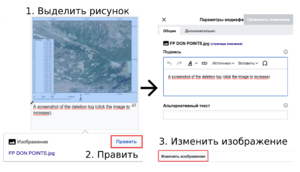Roughness coefficient: различия между версиями
Перейти к навигации
Перейти к поиску
Evg Fil (обсуждение | вклад) |
Evg Fil (обсуждение | вклад) |
||
| Строка 1: | Строка 1: | ||
[[File:example.png|300px|thumb| Изображение описываемого явления с ссылкой на источник.<br /><br />]] | [[File:example.png|300px|thumb| Изображение описываемого явления с ссылкой на источник.<br /><br />]] | ||
| − | ==Коэффициент, который характеризует шероховатость поверхности русла или трубы, вмещающей воду, и который учитывается при расчете сопротивления потока в русле или трубе.<ref name=":0">WMO W.M.O., UNESCO U.N.E. and S.O. International Glossary of Hydrology. – 1998. – 461 с.</ref> | + | ==Коэффициент шероховатости== |
| − | + | Коэффициент, который характеризует шероховатость поверхности русла или трубы, вмещающей воду, и который учитывается при расчете сопротивления потока в русле или трубе.<ref name=":0">WMO W.M.O., UNESCO U.N.E. and S.O. International Glossary of Hydrology. – 1998. – 461 с.</ref> | |
| − | ==Coefficient that characterizes the roughness of a water carrying channel or a pipe and which is taken into account when computing the resistance to flow in the channel or pipe.<ref name=":0" /> | + | ==Определение на английском== |
| − | + | Coefficient that characterizes the roughness of a water carrying channel or a pipe and which is taken into account when computing the resistance to flow in the channel or pipe.<ref name=":0" /> | |
| − | ==In rivers, the most common calibration parameter is the roughness coefficient, that accounts for the friction term.<ref>Ferreira D.M., Fernandes C.V.S., Kaviski E., Bleninger T. Calibration of river hydrodynamic models: Analysis from the dynamic component in roughness coefficients // Journal of Hydrology. – 2021. – Т. 598. – С. 126-136.</ref> | + | ==Пример использования на английском языке== |
| − | + | In rivers, the most common calibration parameter is the roughness coefficient, that accounts for the friction term.<ref>Ferreira D.M., Fernandes C.V.S., Kaviski E., Bleninger T. Calibration of river hydrodynamic models: Analysis from the dynamic component in roughness coefficients // Journal of Hydrology. – 2021. – Т. 598. – С. 126-136.</ref> | |
| − | == | + | ==Перевод на русский== |
| − | + | В реках наиболее распространенным калибровочным параметром является коэффициент шероховатости, который учитывает коэффициент трения. | |
==Список литературы== | ==Список литературы== | ||
<references /> | <references /> | ||
Версия 00:05, 26 апреля 2024
Коэффициент шероховатости
Коэффициент, который характеризует шероховатость поверхности русла или трубы, вмещающей воду, и который учитывается при расчете сопротивления потока в русле или трубе.[1]
Определение на английском
Coefficient that characterizes the roughness of a water carrying channel or a pipe and which is taken into account when computing the resistance to flow in the channel or pipe.[1]
Пример использования на английском языке
In rivers, the most common calibration parameter is the roughness coefficient, that accounts for the friction term.[2]
Перевод на русский
В реках наиболее распространенным калибровочным параметром является коэффициент шероховатости, который учитывает коэффициент трения.
Список литературы
- ↑ Перейти обратно: 1,0 1,1 WMO W.M.O., UNESCO U.N.E. and S.O. International Glossary of Hydrology. – 1998. – 461 с.
- ↑ Ferreira D.M., Fernandes C.V.S., Kaviski E., Bleninger T. Calibration of river hydrodynamic models: Analysis from the dynamic component in roughness coefficients // Journal of Hydrology. – 2021. – Т. 598. – С. 126-136.
